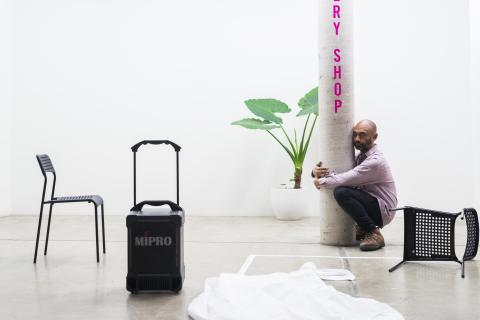Monica Rohan | Artist
By The Last Word
Artlines | 3-2020 | September 2020
Every issue, we invite an artist, curator or friend of the Gallery to share their practice and passions with us. Here, Artlines spoke with contemporary Queensland artist, Future Collective member and Creative Generation alumni Monica Rohan.
Describe your studio/work area.
My studio is the spare room in my apartment. It has large windows which let in plenty of natural light, an easel, a small cabinet holding paints and a large glass palette with brushes. I also have a big desk which is always covered in reference photos and watercolour sketches. It’s a fairly simple, minimal space that allows me to focus on detail in my work, but it has a warm atmosphere which is important for me when I spend so much time there.
What work do you most enjoy doing?
Being in the midst of a painting! When you’re halfway there and everything starts to come together and you get a feel for how it will work out. This feeling eclipses all of the preparation and thought. I do enjoy sorting through reference images and planning paintings, but it’s a very speculative process — more of my decision-making happens during the painting.
What research do you do?
Most of my research time is spent in the landscape, observing and photographing trees. I’ve been drawing a lot of imagery from where I grew up, so have an understanding of what the light will be like at different times of day and what details I want to focus on. I have a large archive of images that I continually add to or revisit, and I also do a lot of sketches and studies, which help me understand my compositions.
How do you know when a work is finished?
It’s finished when there’s no more white space. I don’t really work in layers like traditional oil painting; my process is more like watercolour with mostly a single layer of light brush strokes until the whole surface is covered. There is rarely much I can edit and still retain the transparency that lends the works luminosity. How has your practice changed over time? I think I’ve been steadily expanding my subject matter, exploring what interests me with less restrictions. With earlier works, I was deliberately removing the space around figures, leaving it white to lend more power to the drama of their interactions. As my practice has developed, I’ve gradually reintroduced a setting for the figures in the form of landscapes, trees and furniture. This is a new kind of relationship in the work that I am still playing with.
Name something that other people might be surprised to learn that you love.
Running up hills!
Name an under-appreciated artist/gallery/ work.
If a gallery can be beloved and also underappreciated, then I would mention [the artist-run initiative] Outer Space in South Brisbane. It’s a really important place for young and unrepresented artists in Brisbane, because it gives them the space and support to make large-scale, ambitious projects. They also run studio residencies, workshops and community projects.
Who is your favourite living artist?
Emily Ferretti — the way she uses transparency and immediate mark-making pushes me to try different approaches. I also recently visited Lucy Culliton in her studio. I really love her work and her approach to her practice. And I’ve always really loved Pipilotti Rist and Erwin Wurm.
Feature image: Monica Rohan in her studio / Photograph: Llewellyn Millhouse
Connected objects

Jumble 2015
- ROHAN, Monica - Creator
Related artists
ROHAN, Monica
1990
- present
Full profile
for ROHAN, Monica
Metadata, copyright and sharing information
About this story
- Subject
